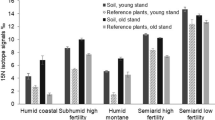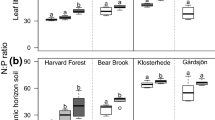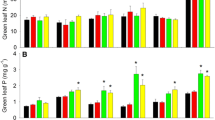Abstract
Storage and flux of nitrogen were studied in several contrasting lodgepole pine (Pinus contorta spp.latifolia) forests in southeastern Wyoming. The mineral soil contained most of the N in these ecosystems (range of 315–860 g · m−2), with aboveground detritus (37.5–48.8g · m−2) and living biomass (19.5–24.0 g · m−2) storing much smaller amounts. About 60–70% of the total N in vegetation was aboveground, and N concentrations in plant tissues were unusually low (foliage = 0.7% N), as were N input via wet precipitation (0.25 g · m−2 · yr−1), and biological fixation of atmospheric N (<0.03 g · m−2 · yr−1, except locally in some stands at low elevations where symbiotic fixation by the leguminous herbLupinus argenteus probably exceeded 0.1 g · m−2 · yr−1).
Because of low concentrations in litterfall and limited opportunity for leaching, N accumulated in decaying leaves for 6–7 yr following leaf fall. This process represented an annual flux of about 0.5g · m−2 to the 01 horizon. Only 20% of this flux was provided by throughfall, with the remaining 0.4g · m−2 · yr−1 apparently added from layers below. Low mineralization and small amounts of N uptake from the 02 are likely because of minimal rooting in the forest floor (as defined herein) and negligible mineral N (< 0.05 mg · L−1) in 02 leachate. A critical transport process was solubilization of organic N, mostly ‘fulvic acids’. Most of the organic N from the forest floor was retained within the major tree rooting zone (0–40 cm), and mineralization of soil organic N provided NH4 for tree uptake. Nitrate was at trace levels in soil solutions, and a long lag in nitrification was always observed under disturbed conditions. Total root nitrogen uptake was calculated to be 1.25 gN · m−2 · yr−1 with estimated root turnover of 0.37-gN · m−2 · yr−1, and the soil horizons appeared to be nearly in balance with respect to N. The high demand for mineralized N and the precipitation of fulvic acid in the mineral soil resulted in minimal deep leaching in most stands (< 0.02 g · m−2 · yr−1). These forests provide an extreme example of nitrogen behavior in dry, infertile forests.
Similar content being viewed by others
References
Binkley, D. 1981. Nodule biomass and acetylene reduction rates of red alder and Sitka alder on Vancouver Island, B.C. Canadian Journal of Forest Research 11: 281–286.
Bormann, F.H., G.E. Likens and J.M. Melillo. 1977. Nitrogen budget for an aggrading northern hardwood forest ecosystem. Science 196: 981–983.
Clark, F.E. and T. Rosswall. 1981. Terrestrial nitrogen cycles, processes, ecosystem strategies and management impacts. Ecological Bulletin (Stockholm) 33.
Cole, D.W. 1958. An alundum tension lysimeter. Soil Science 85: 293–296.
Cole, D.W. and M. Rapp. 1980. Elemental cycling in forest ecosystems. In: D.E. Reichle, (ed.), Dynamic properties of forest ecosystems, pp 341–409. Cambridge University Press Malta.
Cornaby, B.W. and J.B. Waide. 1973. Nitrogen fixation in decaying chestnut logs. Plant and Soil 39: 445–448.
D'Elia, C.F., P.A. Steudler and N. Corwin. 1977. Determination of total nitrogen in aqueous samples using persulfate digestion. Limnology and Oceanography 22: 760–764.
Edmonds, R.L. 1979. Decomposition and nutrient release in Douglas fir needle litter in relation to stand development. Canadian Journal of Forest Research 9: 132–140.
Eno, C.F. 1960. Nitrate production in the field by incubating the soil in polyethylene bags. Soil Science Society of America Proceedings 24: 277–279.
Fahey, T.J. 1979. Water and nutrient cycling in lodgepole pine forest. Ph.D. Dissertation, University of Wyoming, Laramie. 179 p.
Fahey, T.J. 1983. Nutrient dynamics of aboveground detritus in lodgepole pine (Pinus contorta ssp.latifolia) ecosystems, southeastern Wyoming. Ecological Monographs 53: 51–72.
Gessel, S.P. 1962. Progress and problems in mineral nutrition of forest trees. In: T.T. Kozlowski (ed.), Tree growth. pp 221–235. Roland Press, New York, NY.
Gosz, J.R., G.E. Likens and F.H. Bormann. 1973. Nutrient release from decomposing leaf and branch litter in the Hubbard Brook Forest, New Hampshire. Ecological Monographs 42: 173–191.
Hardy, R.W.F., R.C. Burns and R.D. Holsten. 1973. Applications of the acetyleneethylene assay for measurement of nitrogen fixation. Soil Biology and Biochemistry 5: 47–81.
Huffman, E.W.D. 1977. Performance of a new automatic carbon dioxide coulometer. Microchemical Journal 22: 567–573.
Hungate, R.E. 1940. Nitrogen content of sound and decayed coniferous woods and its relation to loss in weight during decay. Botanical Gazette 102: 382–392.
Isaac, R.A. and W.C. Johnson. 1976. Determination of total nitrogen in plant tissue, using a block digestor. Journal of the Association of Official Analytical Chemists 50: 98–100.
Jackson, M.L. 1958. Soil chemical analysis. Prentice-Hall, Englewood Cliffs, New Jersey, USA.
Keeney, D.R. 1980. Prediction of soil nitrogen availability in forest ecosystems: a literature review. Forest Science 26: 159–171.
Knight, D.H., T.J. Fahey and S.W. Running. 1985. Water and nutrient outflow from contrasting lodgepole pine forests in Wyoming. Ecological Monographs 55: 29–48.
Lang, G.E., W.A. Reiners and G.A. Shellito. 1982. Tissue chemistry ofAbies balsamea andBetula papyrifera var.cordifolia from subalpine forests of northeastern United States. Canadian Journal of Forest Research 12: 311–318.
Larsen, M.J., M.F. Jurgensen and A.E. Harvey. 1978. N2 fixation associated with wood decayed by some common fungi in western Montana. Canadian Journal of Forest Research 8: 341–345.
Lawrie, A.C. 1981. Nitrogen fixation by native Australian legumes. Australian Journal of Botany 29: 143–157.
Lawrie, A.C. and C.T. Wheeler. 1973. The supply of photosynthetic assimilates to nodules ofPisum sativum L. in relation to the fixation of nitrogen. New Phytologist 72: 1341–1348.
Lewis, W.M., Jr. and M.C. Grant. 1979. Changes in the output of ions from a watershed as a result of the acidification of precipitation. Ecology 60: 1093–1097.
Likens, G.E., F.H. Bormann, R.S. Pierce, J.S. Eaton and N.M. Johnson. 1977. Biogeochemistry of a forested ecosystem. Springer, New York, NY.
Lousier, J.D. and D. Parkinson. 1978. Chemical element dynamics in decomposing leaf litter. Canadian Journal of Botany 56: 2795–2812.
Lovett, G.M. and S.E. Lindberg. 1983. Dry deposition of nitrate to a deciduous forest canopy. Bulletin of the Ecological Society of America 64: 64.
McClaugherty, C.A., J.D. Aber and J.M. Melillo. 1982. The role of fine roots in the organic matter and nitrogen budgets of two forested ecosystem. Ecology 63: 1481–1490.
Melillo, J.M. 1981. Nitrogen cycling in deciduous forests. In: F.E. Clark and T. Rosswalls (eds.) Terrestrial nitrogen cycles. Process, ecosystem strategies, and management impacts. pp 427–442. Ecological Bulletin 33, Swedish Natural Science Research Council, Stockholm.
Miller, H.G., J.M. Cooper, J.D. Miller and O. Pauline. 1979. Nutrient cycles in pine and their adaptation to poor soils. Canadian Journal of Forest Research 9: 19–26.
Nadelhoffer, K.J., J.D. Aber and J.M. Melillo. 1983. Leaf litter production and soil organic matter dynamics along a nitrogen availability gradient in southern Wisconsin (USA). Canadian Journal of Forest Research 13: 12–21.
Parizek, R.R. and B.E. Lane. 1970. Soil-water sampling using pan and deep pressure-vacuum lysimeters. Journal of Hydrology 11: 1–21.
Pastor, J., J.D. Aber, C.A. McClaugherty and J.M. Melillo. 1984. Above-ground production and N and P cycling along a nitrogen-mineralization gradient on Blackhawk Island, Wisconsin. Ecology 65: 256–268.
Pearson, J.A. 1982. Biomass distribution and ecosystem development in lodgepole pine forests of the Medicine Bow Mountains, Wyoming. Ph.D. Dissertation. University of Wyoming, Laramie, Wyoming, USA.
Pearson J.A., T.J. Fahey and D.H. Knight. 1984. Biomass and leaf area in contrasting lodgepole pine forests. Canadian Journal of Forest Research 14: 259–265.
Raison, R.J. 1979. Modification of the soil environment by vegetation fires, with particular reference to nitrogen transformations: a review. Plant and Soil 51: 73–108.
Rand, M.C. 1976. Standard methods for the examination of water and waste water. American Public Health Association, Washington, DC, USA. 14th edition.
Rapp, M., M.U. LeClerc and P. Loissant. 1979. The nitrogen economy in aPinus pinea L. stand. Forest Ecology and Management 2: 221–231.
Rodin, L.E. and N.E. Bazilevich. 1967. Production and mineral cycling in terrestrial vegetation. Oliver and Boyd, Edinburgh, Scotland.
Roskoski, J.P. 1981. Comparative C2H2 reduction and15N2 fixation in deciduous wood litter. Soil Biology Biochemistry 13: 83–85.
Rutter, A.J., D.A. Kershaw, P.C. Robins and A.J. Morton. 1972. A predictive model of rainfall interception in forests, I. Derivation of the model from observations in a plantation of Corsican pine. Agricultural Meteorology 9: 367–384.
Schuman, G.E., M.A. Stanley and D. Knudsen. 1973. Automated total nitrogen analysis of soil and plant samples. Soil Science Society of America Proceedings 37: 480–481.
Silvester, W.B., P. Sollins, T. Verhoeven and S.P. Cline. 1982. Nitrogen fixation and acetylene reduction in decaying conifer boles: effects of incubation time, aeration, and moisture content. Canadian Journal of Forest Research 12: 646–652.
Small, J.G.C. and O.A. Leonard. 1969. Translocation of14C labelled photosynthate in nodulated legumes as influenced by nitrate nitrogen. American Journal of Botany 56: 187–194.
Sollins, P. and F.M. McCorison. 1981. Nitrogen and carbon solution chemistry of an old growth coniferous forest watershed before and after cutting. Water Resources Research 17: 1409–1418.
Solorzano, L. 1969. Determination of ammonia in natural waters by the phenol-hypochlorite method. Limnology and Oceanography 14: 299–301.
Staaf, H. 1980. Release of plant nutrients from decomposing leaf litter in a south Swedish beech forest. Holoarctic Ecology 3: 129–136.
Tukey, H.B., Jr. 1970. The leaching of substances from plants. Annual Review of Plant Physiology 21: 305–324.
Verry, E.S. and D.R. Timmons. 1977. Precipitation nutrients in the open and under two forests in Minnesota. Canadian Journal of Forest Research 7: 112–119.
Vitousek, P.M. 1982. Nutrient cycling and nutrient use efficiency. American Naturalist 119: 553–572.
Vitousek, P.M., J.R. Gosz, C.C. Grier, J.M. Mellilo and W.A. Reiners. 1982. A comparative analysis of potential nitrification and nitrate mobility in forest ecosystems. Ecological Monographs 52: 155–177.
Vogt, K.A., C.C. Grier, C.E. Meier and R.L. Edmonds. 1982. Mycorrhizal role in net primary production and nutrient cycling inAbies amabilis ecosystems in western Washington. Ecology 63: 370–380.
Yavitt, J.B. and T.J. Fahey. 1982. Loss of mass and nutrient changes of decaying woody roots in lodgepole pine forests, southeastern Wyoming. Canadan Journal of Forest Research 12: 745–752.
Yavitt, J.B. and T.J. Fahey. 1984. An experimental analysis of solution chemistry in a lodgepole pine forest floor. Oikos 43:222–234.
Yavitt, J.B. and T.J. Fahey. (in press). Organic chemistry of the soil solution during snowmelt leaching inPinus contorta forest ecosystems, Wyoming, USA, In: Planetary Ecology: selected papers from the 6th International Symposium on Environmental Biogeochemistry. The Ronald Press, New York.
Yavitt, J.B. and T.J. Fahey. Forest floor leaching and litter decay in lodgepole pine ecosystems. Submitted to Journal of Ecology.
Author information
Authors and Affiliations
Rights and permissions
About this article
Cite this article
Fahey, T.J., Yavitt, J.B., Pearson, J.A. et al. The nitrogen cycle in lodgepole pine forests, southeastern Wyoming. Biogeochemistry 1, 257–275 (1985). https://doi.org/10.1007/BF02187202
Issue Date:
DOI: https://doi.org/10.1007/BF02187202




